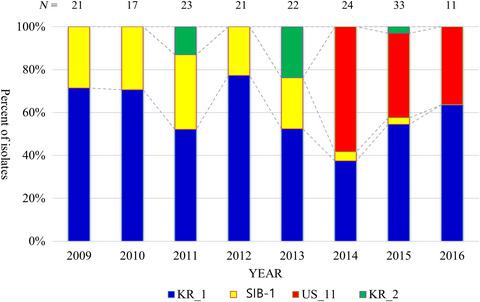当前位置:
X-MOL 学术
›
Plant Pathol.
›
论文详情
Our official English website, www.x-mol.net, welcomes your
feedback! (Note: you will need to create a separate account there.)
Genotypic and Phenotypic Characterization of Phytophthora infestans in South Korea during 2009‐2016 reveals Clonal Reproduction and Absence of EU_13_A2 Genotype
Plant Pathology ( IF 2.3 ) Pub Date : 2020-04-04 , DOI: 10.1111/ppa.13178 Jang‐Gyu Choi 1 , Su‐Young Hong 1 , Geert J. T. Kessel 2 , David E. L. Cooke 3 , Jack H. Vossen 2 , Ji‐Hong Cho 1 , Ju‐Seong Im 1 , Young‐Eun Park 1 , Kwang‐Soo Cho 1
Plant Pathology ( IF 2.3 ) Pub Date : 2020-04-04 , DOI: 10.1111/ppa.13178 Jang‐Gyu Choi 1 , Su‐Young Hong 1 , Geert J. T. Kessel 2 , David E. L. Cooke 3 , Jack H. Vossen 2 , Ji‐Hong Cho 1 , Ju‐Seong Im 1 , Young‐Eun Park 1 , Kwang‐Soo Cho 1
Affiliation

|
In order to better understand the Phytophthora infestans population structure in South Korea, 172 isolates were collected between 2009 and 2016 from four major potato cultivation areas. Fungicide (metalaxyl and dimethomorph) response, mating type, and microsatellite (SSR) genetic fingerprints were analysed to characterize these isolates. Ten isolates collected in Gyeongnam Province, which specializes in protected winter cultivation in polytunnels, were A2 mating type. All other isolates were A1 mating type. Overall, 42% of the isolates were resistant to metalaxyl, and 43% were sensitive. All isolates were sensitive to dimethomorph. From the SSR fingerprints, 45 distinct genotypes were identified, which could be clustered into four clonal lineages: KR_1_A1, KR_2_A2, SIB-1, and US-11. KR_1_A1 was the predominant P. infestans genotype in South Korea. KR_2_A2 was only found in Gyeongnam Province; all isolates were A2 mating type and resistant to metalaxyl. SIB-1 was dominant until 2013 but its frequency has gradually decreased in more recent years. US-11 was first found in 2014, after which its frequency has increased to become codominant with KR_1_A1. The calculated standardized index of association (IA) suggests that the South Korean P. infestans population is undergoing clonal reproduction. When compared with populations of P. infestans from the Netherlands, it has less genetic diversity and the dominant Netherlands P. infestans genotype, EU_13_A2 (Blue_13), was not found in South Korea. Such monitoring of the pathogen population contributes to a more efficient integrated pest management-based control strategy for potato late blight control in South Korea.
中文翻译:

2009-2016 年韩国致病疫霉的基因型和表型特征揭示了 EU_13_A2 基因型的克隆繁殖和缺失
为了更好地了解韩国的致病疫霉种群结构,在 2009 年至 2016 年期间从四个主要马铃薯种植区收集了 172 株分离株。分析了杀菌剂(甲霜灵和二甲酰吗啉)反应、交配类型和微卫星 (SSR) 遗传指纹以表征这些分离株。在专门从事多隧道保护性冬季栽培的庆南省收集的 10 个分离株为 A2 交配型。所有其他分离株均为 A1 交配型。总体而言,42% 的分离株对甲霜灵具有抗性,43% 的分离株敏感。所有分离株都对二甲吗啉敏感。从 SSR 指纹中,确定了 45 个不同的基因型,它们可以分为四个克隆谱系:KR_1_A1、KR_2_A2、SIB-1 和 US-11。KR_1_A1 是韩国主要的致病疫霉基因型。KR_2_A2仅在庆南省被发现;所有分离株均为A2交配型,对甲霜灵耐药。SIB-1 在 2013 年之前一直占主导地位,但近年来其频率逐渐下降。US-11 于 2014 年首次被发现,此后其频率增加至与 KR_1_A1 共显性。计算的标准化关联指数 (IA) 表明韩国 P. infestans 种群正在经历克隆繁殖。与来自荷兰的 P. infestans 种群相比,它的遗传多样性较少,并且在韩国未发现占优势的荷兰 P. infestans 基因型 EU_13_A2 (Blue_13)。对病原体种群的这种监测有助于为韩国马铃薯晚疫病防治制定更有效的综合病虫害管理控制策略。
更新日期:2020-04-04
中文翻译:

2009-2016 年韩国致病疫霉的基因型和表型特征揭示了 EU_13_A2 基因型的克隆繁殖和缺失
为了更好地了解韩国的致病疫霉种群结构,在 2009 年至 2016 年期间从四个主要马铃薯种植区收集了 172 株分离株。分析了杀菌剂(甲霜灵和二甲酰吗啉)反应、交配类型和微卫星 (SSR) 遗传指纹以表征这些分离株。在专门从事多隧道保护性冬季栽培的庆南省收集的 10 个分离株为 A2 交配型。所有其他分离株均为 A1 交配型。总体而言,42% 的分离株对甲霜灵具有抗性,43% 的分离株敏感。所有分离株都对二甲吗啉敏感。从 SSR 指纹中,确定了 45 个不同的基因型,它们可以分为四个克隆谱系:KR_1_A1、KR_2_A2、SIB-1 和 US-11。KR_1_A1 是韩国主要的致病疫霉基因型。KR_2_A2仅在庆南省被发现;所有分离株均为A2交配型,对甲霜灵耐药。SIB-1 在 2013 年之前一直占主导地位,但近年来其频率逐渐下降。US-11 于 2014 年首次被发现,此后其频率增加至与 KR_1_A1 共显性。计算的标准化关联指数 (IA) 表明韩国 P. infestans 种群正在经历克隆繁殖。与来自荷兰的 P. infestans 种群相比,它的遗传多样性较少,并且在韩国未发现占优势的荷兰 P. infestans 基因型 EU_13_A2 (Blue_13)。对病原体种群的这种监测有助于为韩国马铃薯晚疫病防治制定更有效的综合病虫害管理控制策略。









































 京公网安备 11010802027423号
京公网安备 11010802027423号